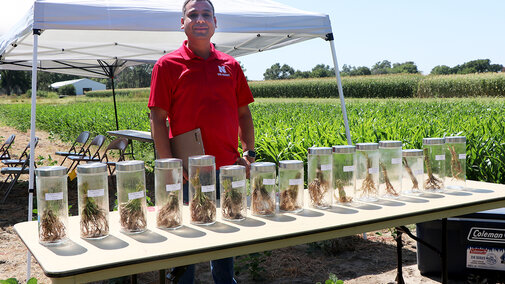Field tours were conducted at the West Central Research Extension and Education Center (WCREEC) of the University of Nebraska-Lincoln (UNL) in North Platte during its Annual Water and Crops Field Day on Aug. 24. The event highlighted a research project on cover crops, which is a four-year collaboration between UNL and the Nebraska NRCS aimed at understanding and promoting the use of cover crops in Nebraska. This project establishes trials with diverse cover crop species or varieties at multiple locations across the state, including five UNL research stations with differing climatic conditions.
Cover crops are gaining attention because of their potential benefits on soil health and forage purposes.
“While the benefits of cover crops are widely discussed, it’s essential to know that not all cover crop species are suitable for every location. Therefore, our project’s goal is to pinpoint the best-adapted cover crop species or varieties for unique ecoregions across Nebraska,” said Vesh R. Thapa, a UNL postdoctoral research associate who coordinates and supports the project.
Thapa emphasized that selecting appropriate species based on locally sourced data is crucial for successful cover crop use.
Recognizing that the cover crop impact extends beneath the soil’s surface is crucial.
“What lies beneath the surface is equally as significant as what appears above it,” Thapa said.
Roots are the hidden half of the plants. Live roots of cover crops play a vital role in nourishing soil microbes by releasing a variety of nutritious compounds. The structure and distribution of these roots influence several ecosystem services provided by cover crops.
At WCREEC, experimental plots feature a variety of warm-season cover crop species, including grasses, legumes, brassicas, broadleaves and their combinations. Each type of species generates a unique root system that contributes differently to soil health. For example, grasses produce dense fibrous root systems and more root biomass that effectively help prevent soil erosion. On the other hand, legumes and brassicas, although they produce less extensive root systems and low root biomass, contribute to nutrient cycling and help with nitrogen fixation, disease control and weed management.
"A dense, fibrous root system, microbial exudates, enmeshing action of fungal hyphae, and earthworm casts/activities all help form soil aggregates,” Thapa said. “These improved aggregates enhance pore space, which improves soil infiltration. Live roots in the soil also create channels that increase infiltration capacity. Well-structured soil aggregates reduce the risk of wind and water erosion. Legume roots contain nodules where nitrogen-fixing bacteria execute biological nitrogen fixation.
“The project is halfway through, and there’s still more to learn,” Thapa concluded.

